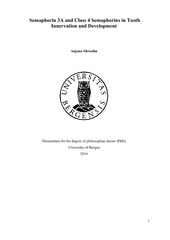Semaphorin 3A and Class 4 Semaphorins in Tooth Innervation and Development
Doctoral thesis
Permanent lenke
https://hdl.handle.net/1956/8674Utgivelsesdato
2014-10-10Metadata
Vis full innførselSamlinger
Sammendrag
Background: Dental trigeminal axon elongation, navigation and patterning occur in a controlled manner that is intimately linked to tooth shape formation and cell differentiation. Development of tooth results from sequential and reciprocal molecular interactions between epithelial and mesenchymal tissues. Semaphorin family of secreted and membrane-bound axonal growth cone guiding molecules regulates the development of the nervous system and also serves important non-neuronal functions. Many Semaphorins are expressed in the developing tooth germ and there is evidence that Semaphorin signalling regulates tooth innervation. Objective: To investigate mRNA expression of class 4 semaphorins and their PlexinB receptors in the developing mouse mandibular first molar, and to study further functions of Sema3A during odontogenesis. Materials and methods: Transgenic Sema3A-deficient mice in C57BL/6 and CD1 background as well as NMRI mice were used. In situ hybridization and immunohistochemistry was employed to localize mRNAs and neurites on tissue sections of embryonic and postnatal teeth. In addition, western blot was used to investigate presence of class 4 Semaphorins in postnatal mandibular first molar tooth germ and trigeminal ganglion. Computed tomography was applied to study adult teeth. Results: Sema4A and Sema4D as well as PlexinB1 and -B2 receptor mRNAs were expressed in the postnatal molar tooth germ. Sema4D, PlxnB1 and PlxnB2 proteins were also found in the postnatal molar tooth germ and trigeminal ganglion. Sema3A showed dynamic expression in the developing mandibular incisor. Analysis of the Sema3A-deficient mice revealed that Sema3A signaling is required for proper innervation of the embryonic and postnatal incisor tooth germ as well as postnatal molar whereas no apparent histomorphological defects in the development of tooth germs were observed. Conclusions: The expression domains of the class 4 semaphorins suggest that they may serve both neuronal and non-neuronal functions during odontogenesis. Sema3A controls innervation of the pulp and periodontium during tooth development. The putative, neuronal and non-neuronal roles of the semaphorins, which may be redundant during odontogenesis, remain to be analysed in the future.
Består av
Paper I: Kyaw Moe, Anjana Shrestha, Inger Hals Kvinnsland, Keijo Luukko and Päivi Kettunen (2011). Developmentally regulated expression of Sema3A chemorepellent in the developing mouse incisor. Acta Odontologica Scandinavica.70, 184-189. The article is not available in BORA due to publisher restrictions. The published version is available at: http://dx.doi.org/10.3109/00016357.2011.600717Paper II: Kyaw Moe, Angelina Sijaona, Anjana Shrestha, Päivi Kettunen, Masahiko Taniguchi and Keijo Luukko (2012). Semaphorin3A controls timing and patterning of the dental pulp innervation. Differentiation. 84, 371-379. The article is not available in BORA due to publisher restrictions. The published version is available at: http://dx.doi.org/10.1016/j.diff.2012.09.003
Paper III: Anjana Shrestha, Kyaw Moe, Keijo Luukko, Masahiko Taniguchi and Päivi Kettunen. (2014) Sema3A chemorepellent regulates the timing and patterning of the dental nerves during the development of incisor tooth germ. Cell and Tissue Research. 357, 15-29. The article is not available in BORA due to publisher restrictions. The published version is available at: http://dx.doi.org/10.1007/s00441-014-1839-3
Paper IV: Anjana Shrestha, Keijo Luukko and Päivi Kettunen. Dynamic expression of Class 4 semaphorins and PlexinB receptor mRNAs in the early postnatal mouse molar suggests neuronal and non-neuronal functions during odontogenesis. The article is not available in BORA.
